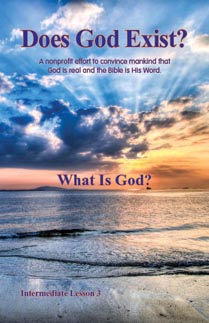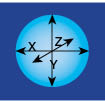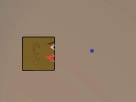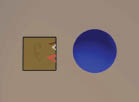Lesson 3
WHAT
IS GOD?
 In the first two lessons of this course, we have
established some logical and scientifically supported facts about the
creation of time, space, and matter/energy. We have seen that there was
a beginning to the physical cosmos. We have seen that the beginning had
to be caused. We have also seen that chance cannot be a valid cause for
the beginning. The complexity of the creation excludes blind,
mechanistic chance as a valid cause. Our next step is to ask, “What
would have to be the nature of an alternative to chance?”
In the first two lessons of this course, we have
established some logical and scientifically supported facts about the
creation of time, space, and matter/energy. We have seen that there was
a beginning to the physical cosmos. We have seen that the beginning had
to be caused. We have also seen that chance cannot be a valid cause for
the beginning. The complexity of the creation excludes blind,
mechanistic chance as a valid cause. Our next step is to ask, “What
would have to be the nature of an alternative to chance?”
To help the reader comprehend the nature of this cause I would like to
borrow an analogy from the book, Flatland,
by
Edwin Abbot. It was originally written in the nineteenth century for
the same purposes we are using it here, to challenge the reader’s
thinking. Abbot was a mathematician and the model is geometric in
nature.


Flatland is the story of a
man who lives in Flatland--a world with only two dimensions like a
sheet of paper. On the surface of the paper there are only length and
width--there is no such thing as thickness. You and I are
three-dimensional beings--we have length and width and frequently,
considerable thickness. You cannot get me, a three-dimensional being,
into a two-dimensional sheet of paper. You can draw a front view of me
(a portrait), but that is not the whole me. You can draw a top view of
me (which, because I am bald, is three concentric circles), but that is
not the whole me. If you and I were to look at the man in Flatland, we
would see him as a profile. He would be outlined but have no thickness.
One day the man in Flatland is visited by a sphere. The sphere is a
three-dimensional object just as we are, and it just so happens that it
crosses Flatland right in the man’s living room. Now if you will think
about that for a moment, you will realize that for the man in Flatland
a rather incredible thing has happened. A dot appears on the man’s
floor with no cause that the man in Flatland can understand. A dot in
Flatland is matter! The man in Flatland is made of lines, each of which
is a series of dots. Imagine a tennis ball dipped in  paint and touched to a
sheet of paper leaving a dot. In the same way the dot, which the man in
Flatland calls matter, appeared out of nothing. As the man in Flatland
watches, the dot becomes a circle which continuously grows in size. If
a plane truncates (or slices) a sphere, it will produce a circle; and
the deeper the sphere sinks into the plane, the larger the circle will
become.
paint and touched to a
sheet of paper leaving a dot. In the same way the dot, which the man in
Flatland calls matter, appeared out of nothing. As the man in Flatland
watches, the dot becomes a circle which continuously grows in size. If
a plane truncates (or slices) a sphere, it will produce a circle; and
the deeper the sphere sinks into the plane, the larger the circle will
become.
The circle becomes so large it is about to fill the living room of the
man in Flatland. He is terrified because he does not understand what is
happening. All the laws of science which state that matter cannot be
created or destroyed are being violated. What he sees is for him a true
miracle. Just as he is about to run in panic from the room, the sphere
reaches its equator, passes its equator, and gradually sinks out of the
plane. So what happens to the circle in Flatland? It begins to shrink,
and it becomes smaller and smaller until finally it is just a dot on
his floor, and then it is gone! Another violation of the laws of
science!

Matter cannot be destroyed and yet the man in Flatland has seen it
happen. The man in Flatland is being confronted with miraculous and
ghost-like events which violate his science and his common sense.
Let us suppose now that the man in Flatland begins talking to the
sphere, and he says to the sphere: “What is it like to be a sphere?”
The sphere says, “I’ll tell you what it’s like;  draw a circle on your
floor.” This is not easy for the man in Flatland to do. His perception
of a circle is a constantly curving line that returns to its origin,
but he cannot see all of the circle at once. He can only see the side
of the circle facing him. The only way he could see a whole circle
would be to be inside the circle, and if he got inside he could never
get out. People in Flatland commit suicide by drawing circles around
themselves because they can never get out.
draw a circle on your
floor.” This is not easy for the man in Flatland to do. His perception
of a circle is a constantly curving line that returns to its origin,
but he cannot see all of the circle at once. He can only see the side
of the circle facing him. The only way he could see a whole circle
would be to be inside the circle, and if he got inside he could never
get out. People in Flatland commit suicide by drawing circles around
themselves because they can never get out.
Because of his dimensional limitations it takes a long time for him to
draw the circle. The sphere is most impatient with all this because he
could have done it instantly. Finally the  circle is completed and the
sphere says, “Now what I want you to do is to rotate the circle!” What
he has in mind is that the man in Flatland will rotate the circle
around its diameter, producing a sphere. But what the man in Flatland
does is to rotate the circle around its circumference, spinning it like
a CD in a CD player. “No, no, rotate it the third way,” says the
sphere. “There is no third way, you fool!” cries out the man in
Flatland, and for him this is true. There is no third way, no up and
down in a thickness direction, and absolutely no way for him to
comprehend what the sphere is talking about, or what the sphere is. The
only thing that he can understand is the world or dimension in which he
lives.
circle is completed and the
sphere says, “Now what I want you to do is to rotate the circle!” What
he has in mind is that the man in Flatland will rotate the circle
around its diameter, producing a sphere. But what the man in Flatland
does is to rotate the circle around its circumference, spinning it like
a CD in a CD player. “No, no, rotate it the third way,” says the
sphere. “There is no third way, you fool!” cries out the man in
Flatland, and for him this is true. There is no third way, no up and
down in a thickness direction, and absolutely no way for him to
comprehend what the sphere is talking about, or what the sphere is. The
only thing that he can understand is the world or dimension in which he
lives.
 This story is designed to
stretch our thinking and understanding. Whatever the cause of the
beginning was, it had to be in a higher dimension than space, time and
energy. In recent years scientists have proposed theories of “branes”
and “strings” and similar such entities that are in a higher dimension
than X, Y, Z, and time. The problem with these explanations is that
they do not account for the intelligence, design, and purpose that we
see in the cosmos. What does account for these properties is the
concept of a Supreme Being that is in a higher dimension than we are,
and who has a purpose in creating in our four-dimensional “flatland’’
of X, Y, Z, and time. At this point we are not offering evidence of
which God, but rather we are talking about what the nature of this God
would have to be.
This story is designed to
stretch our thinking and understanding. Whatever the cause of the
beginning was, it had to be in a higher dimension than space, time and
energy. In recent years scientists have proposed theories of “branes”
and “strings” and similar such entities that are in a higher dimension
than X, Y, Z, and time. The problem with these explanations is that
they do not account for the intelligence, design, and purpose that we
see in the cosmos. What does account for these properties is the
concept of a Supreme Being that is in a higher dimension than we are,
and who has a purpose in creating in our four-dimensional “flatland’’
of X, Y, Z, and time. At this point we are not offering evidence of
which God, but rather we are talking about what the nature of this God
would have to be.
It may sound, then, as if God cannot be understood. While our minds do
have limitations, this is simply not the case. What we must do to
understand God’s nature is to apply a technique of science. How do we
understand an electron? We cannot see an electron because it is too
small. We cannot hear, touch, smell, or taste a single electron for the
same reason. How we are able to understand an electron is by studying
its properties.
By rubbing a hard rubber rod on a piece of fur and touching it to a
detector, we can establish some of the electron’s properties, such as
charge. By more elaborate experiments, we can establish other
properties of electrons, such as mass and spin. Eventually, we can
identify many properties so that we can begin to use electrons for
practical devices like televisions and computers. The same method is
involved in understanding quarks, neutrinos, photons, mesons, and a
variety of other phenomena in science.
Other non-physical things such as love, loyalty, patriotism, and the
like are handled in the same way. To understand God, we must study His
properties.
GOD AND TIME
One of the more important attributes of God to understand is the fact
that God is independent of time. God created time! All points of time
are NOW to God.
Einstein verified the relative nature of time. Time is not an ethereal
substance evenly flowing through the cosmos. Time is a created thing,
existent so that matter can exist and so that the physical world can be.
Think of the understandings which are linked to the realization that
God is independent of time! How can God hear all of our prayers at
once? God has all of eternity to listen to the last second prayer of a
pilot as his plane goes down in flames. Time does not limit God.
How long did God need to create the earth? None at all! God created
time. He could have done everything or anything in an instant or He
could take trillions of years.
What is eternity? It is that situation where time does not exist.
Realize that if there is no time, there will be no aging and thus no
death. Death is dependent on the passage of time. There will also be no
physical pain or tears or crying! All of these things depend on time.
Where did God come from or who created God? If God created time, then
He was in existence before the beginning. This means God had no
beginning and He was not created. In fact, the only way physical matter
can exist is to be created by a time-independent God. When time stops,
matter will dissolve.
GOD AND SPACE
One of Einstein’s more interesting concepts involves the relationship
of time and space. The point is that space and time are intimately
related. In astronomy today, we speak of “space/time,” indicating this
interdependence. To visualize this, think of how you could travel if
you were independent of the time limitations. If time did not pass for
you, you could be in California, New York, Miami, and on the moon all
at the same time–instantaneously! We often say ,’’If only I had time, I
would do … (whatever we did not get done).” We all recognize that time
limits what we can do and where we can be in space.
If God is independent of time, then it logically follows that He must
also be unlimited in space. If every piece of time is NOW to God, then
every point in space must also be HERE AND NOW to God. The idea that
God is everywhere makes perfect sense when we understand it in this way.
No matter what “God’’ someone may be talking about, the properties that
we have been discussing in this lesson must apply. It is only with this
concept of God that the scientific evidence we have been discussing
makes sense. We cannot help but notice that the biblical concept of God
matches all of this perfectly. In fact there is a massive amount of
evidence that there is one God, and that it is the God described in the
Bible. In our age of relativism there is a tendency to present all
claims of God to be equally valid, but that is not supported by the
evidence. The biblical portrayal of God is unique and in perfect
agreement with all of the evidence.
 Many people have a physical
“old man in the sky’’ concept. We have a tendency to create God in our
image instead of the other way around. It seems we all fall into the
trap of conceiving of a God with the same weaknesses and prejudices
that we have, and we totally miss the real nature of God. We also cause
enormous problems and doubts which are precipitated by our physical and
anthropomorphic visualization of God.
Many people have a physical
“old man in the sky’’ concept. We have a tendency to create God in our
image instead of the other way around. It seems we all fall into the
trap of conceiving of a God with the same weaknesses and prejudices
that we have, and we totally miss the real nature of God. We also cause
enormous problems and doubts which are precipitated by our physical and
anthropomorphic visualization of God.
From both a biblical and a logical standpoint, it should be clear that
God cannot rationally be understood as a man or a physical entity. We
read descriptions of God in the Bible and, without exception, these
descriptions are non-physical and non-anthropomorphic. Consider this
partial list:
John 4:24: “God is a Spirit: and they
that worship him must worship him in spirit and in truth.”
Matthew 16:17: “… Blessed art thou, Simon Barjona: for flesh and blood
hath not revealed it unto thee, but my Father which is in heaven.”
1 John 1:5: “… God is light, and in him is no darkness … .”
1 John 4:8: “… God is love.”
1 John 4:16: “… God is love; and he that dwelleth in love dwelleth in
God, and God in him.”
Numbers 23:19: “God is not a man, that he should lie; neither the son
of man, that he should repent: …”
Isaiah 55:9: “For as the heavens are higher than the earth, so are my
ways higher than your ways, and my thoughts than your thoughts.”
Job 9:32: “For he is not a man, as I am, that I should answer him, and
we should come together in judgment.”
It is true that physical or human descriptions may be applied to God
when the Bible explains how God does things. Consider these examples:
Psalm 36:7: “How excellent is thy
lovingkindness, O God! therefore the children of men put their trust
under the shadow of thy wings.”
1 Peter 3:12: “For the eyes of the Lord are over the righteous, and his
ears are open unto their prayers: but the face of the Lord is against
them that do evil.”
Numbers 11:23: “And the LORD said unto Moses, Is the LORD’S hand waxed
short?’’
Acts 11:21: “And the hand of the Lord was with them: …”
This use of accommodative language is familiar to all of us. When we
talk about “the long arm of the law,” do we mean that breaking a speed
limit might cause a hand to come out of the sky and pick us up out of
our car? Does “the face of America’’ refer to an actual face? These are
words used to describe how something is or acts. So, too, are such
descriptions of God’s activity. All descriptions of God, however, are
totally non-anthropomorphic and non-physical.
In addition to the descriptions of God being free of physical and human
traits, there are numerous biblical descriptions compatible with the
concept of God being outside of time and space. Passages like Acts
17:28 describe our relationship with God in realistic terms: “For in
him we live, and move, and have our being; …” Jesus repeatedly told his
followers “My kingdom is not of this world’’ trying to emphasize the
freedom God has from time and space and human structures. Even the
description of death tells us that when we arrive at death there will
be “… no more death, neither sorrow, nor crying, neither shall there be
any more pain: for the former things are passed away” (Revelation 21:4).
A PREVIEW OF THE
NEXT LESSON
In our next lesson we want to pursue the uniqueness of Christianity to
a greater extent. Jesus said “I am the way, the truth, and the life: no
man cometh unto the Father, but by me” (John 14:6). What evidence do we
have to support that statement? How do we know that the Bible is the
Word of God and that competing claims from other religious books are
not equally valid? That will be the subject of our next lesson.
Lesson 3 Questions
Return to the Main
Page
for the
Intermediate Correspondence Course.
10/13/2009
 In the first two lessons of this course, we have
established some logical and scientifically supported facts about the
creation of time, space, and matter/energy. We have seen that there was
a beginning to the physical cosmos. We have seen that the beginning had
to be caused. We have also seen that chance cannot be a valid cause for
the beginning. The complexity of the creation excludes blind,
mechanistic chance as a valid cause. Our next step is to ask, “What
would have to be the nature of an alternative to chance?”
In the first two lessons of this course, we have
established some logical and scientifically supported facts about the
creation of time, space, and matter/energy. We have seen that there was
a beginning to the physical cosmos. We have seen that the beginning had
to be caused. We have also seen that chance cannot be a valid cause for
the beginning. The complexity of the creation excludes blind,
mechanistic chance as a valid cause. Our next step is to ask, “What
would have to be the nature of an alternative to chance?”

 paint and touched to a
sheet of paper leaving a dot. In the same way the dot, which the man in
Flatland calls matter, appeared out of nothing. As the man in Flatland
watches, the dot becomes a circle which continuously grows in size. If
a plane truncates (or slices) a sphere, it will produce a circle; and
the deeper the sphere sinks into the plane, the larger the circle will
become.
paint and touched to a
sheet of paper leaving a dot. In the same way the dot, which the man in
Flatland calls matter, appeared out of nothing. As the man in Flatland
watches, the dot becomes a circle which continuously grows in size. If
a plane truncates (or slices) a sphere, it will produce a circle; and
the deeper the sphere sinks into the plane, the larger the circle will
become.

 draw a circle on your
floor.” This is not easy for the man in Flatland to do. His perception
of a circle is a constantly curving line that returns to its origin,
but he cannot see all of the circle at once. He can only see the side
of the circle facing him. The only way he could see a whole circle
would be to be inside the circle, and if he got inside he could never
get out. People in Flatland commit suicide by drawing circles around
themselves because they can never get out.
draw a circle on your
floor.” This is not easy for the man in Flatland to do. His perception
of a circle is a constantly curving line that returns to its origin,
but he cannot see all of the circle at once. He can only see the side
of the circle facing him. The only way he could see a whole circle
would be to be inside the circle, and if he got inside he could never
get out. People in Flatland commit suicide by drawing circles around
themselves because they can never get out. circle is completed and the
sphere says, “Now what I want you to do is to rotate the circle!” What
he has in mind is that the man in Flatland will rotate the circle
around its diameter, producing a sphere. But what the man in Flatland
does is to rotate the circle around its circumference, spinning it like
a CD in a CD player. “No, no, rotate it the third way,” says the
sphere. “There is no third way, you fool!” cries out the man in
Flatland, and for him this is true. There is no third way, no up and
down in a thickness direction, and absolutely no way for him to
comprehend what the sphere is talking about, or what the sphere is. The
only thing that he can understand is the world or dimension in which he
lives.
circle is completed and the
sphere says, “Now what I want you to do is to rotate the circle!” What
he has in mind is that the man in Flatland will rotate the circle
around its diameter, producing a sphere. But what the man in Flatland
does is to rotate the circle around its circumference, spinning it like
a CD in a CD player. “No, no, rotate it the third way,” says the
sphere. “There is no third way, you fool!” cries out the man in
Flatland, and for him this is true. There is no third way, no up and
down in a thickness direction, and absolutely no way for him to
comprehend what the sphere is talking about, or what the sphere is. The
only thing that he can understand is the world or dimension in which he
lives. This story is designed to
stretch our thinking and understanding. Whatever the cause of the
beginning was, it had to be in a higher dimension than space, time and
energy. In recent years scientists have proposed theories of “branes”
and “strings” and similar such entities that are in a higher dimension
than X, Y, Z, and time. The problem with these explanations is that
they do not account for the intelligence, design, and purpose that we
see in the cosmos. What does account for these properties is the
concept of a Supreme Being that is in a higher dimension than we are,
and who has a purpose in creating in our four-dimensional “flatland’’
of X, Y, Z, and time. At this point we are not offering evidence of
which God, but rather we are talking about what the nature of this God
would have to be.
This story is designed to
stretch our thinking and understanding. Whatever the cause of the
beginning was, it had to be in a higher dimension than space, time and
energy. In recent years scientists have proposed theories of “branes”
and “strings” and similar such entities that are in a higher dimension
than X, Y, Z, and time. The problem with these explanations is that
they do not account for the intelligence, design, and purpose that we
see in the cosmos. What does account for these properties is the
concept of a Supreme Being that is in a higher dimension than we are,
and who has a purpose in creating in our four-dimensional “flatland’’
of X, Y, Z, and time. At this point we are not offering evidence of
which God, but rather we are talking about what the nature of this God
would have to be. Many people have a physical
“old man in the sky’’ concept. We have a tendency to create God in our
image instead of the other way around. It seems we all fall into the
trap of conceiving of a God with the same weaknesses and prejudices
that we have, and we totally miss the real nature of God. We also cause
enormous problems and doubts which are precipitated by our physical and
anthropomorphic visualization of God.
Many people have a physical
“old man in the sky’’ concept. We have a tendency to create God in our
image instead of the other way around. It seems we all fall into the
trap of conceiving of a God with the same weaknesses and prejudices
that we have, and we totally miss the real nature of God. We also cause
enormous problems and doubts which are precipitated by our physical and
anthropomorphic visualization of God.